One of my co-workers shared with me that their dryer would no longer heat. I thought I could figure it out so I opted to take a look at it. My first thought was that it was the igniter so that is what I went after at first. I was able to fix it and here are the steps to troubleshoot and fix a Kenmore 90 Series Dryer that runs but will not heat…
How to Fix a Kenmore 90 Series Gas Dryer That Will Not Heat
Hardware:
- Kenmore 90 Series Gas Dryer Model 110.76902693, Type DDOT-NAT-1206006-CV22
Possible Faulty Parts:
- Multimeter, I really like my Fluke 177 True RMS Digital Multimeter with Backlight
- Phillips and flat-head screw drivers
- 1/4″ socket and 1/4″ socket ratchet (get these and all the other sockets you’ll need with this set here
)
If you’re interested, here’s the electrical schematic of this dryer (we found this paper schematic inside the dryer):
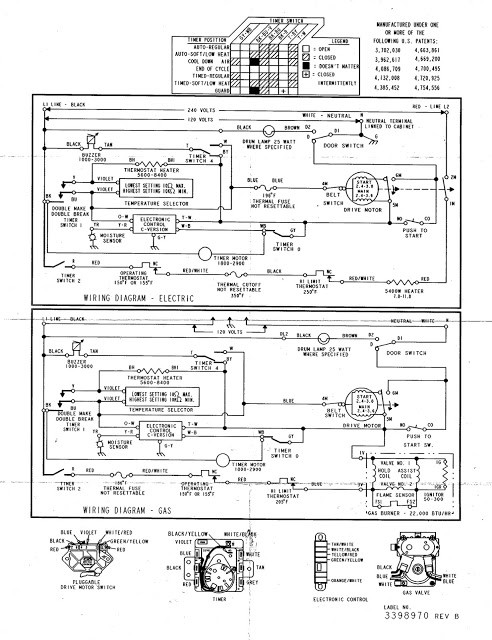 |
| Schematic for Kenmore 90 Series Model 110.76902693 |
Caution: When you open this dryer there will be sharp edges on the metal parts so be careful.
Step 1: Unplug the dryer from the wall and turn off the gas!!
The parts we are going to touch will be live so you don’t want to get shocked. Turning the gas off is just a precaution. The valve arm should be perpendicular to the pipe when it is turned off (versus in line with the pipe when it is on). here’s a gas valve in the off position:
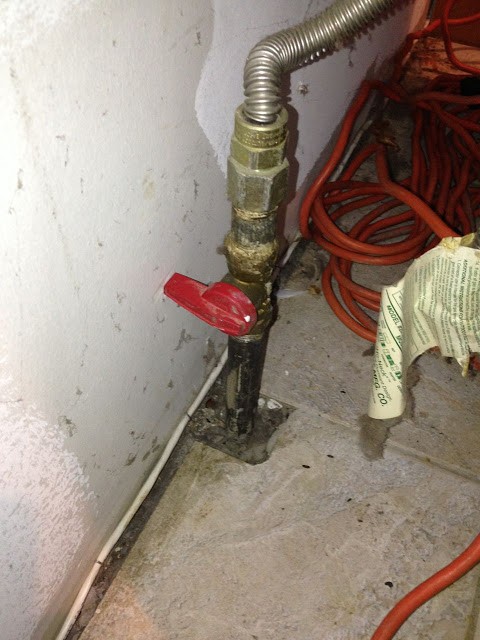 |
| Gas valve OFF |
Step 2: Release the two top spring clips from the lower front panel.
There are two spring clips on the top edge that must be pressed down to release the lower front panel. Take a flat screwdriver and press them down will pulling out on the panel.
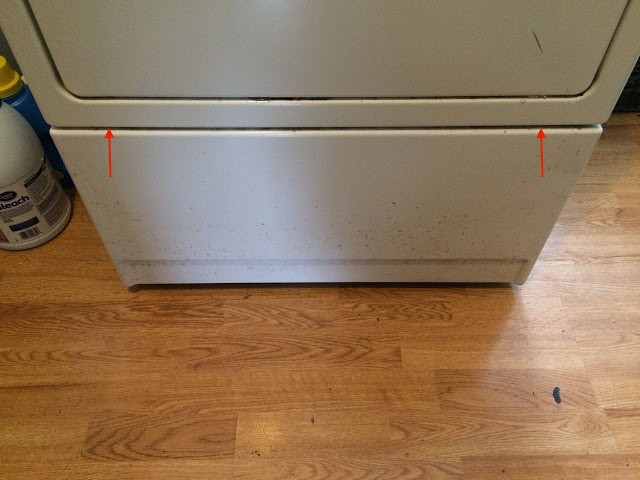 |
| Location of the spring clips that hold the top of the lower front panel on the dryer |
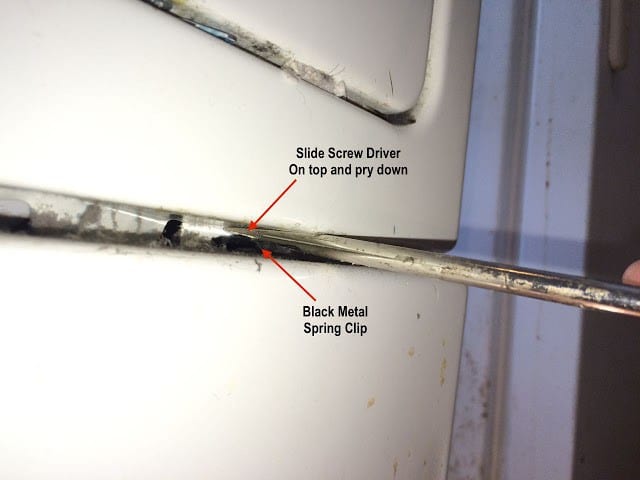 |
| Prying the spring clip down to release the front panel door |
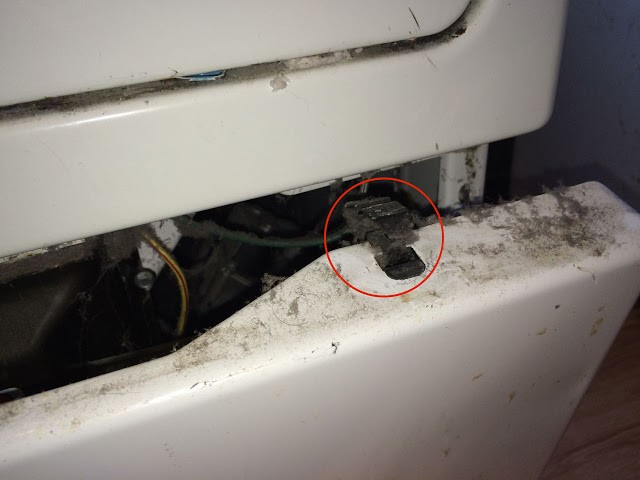 |
| Here’s what the spring clip looks like with the door released |
Step 3: Lift the door up and off the two springs that slide into slots in the bottom of the door.
With the door at the angle shown below lift it up and off the lower springs, circled in red:
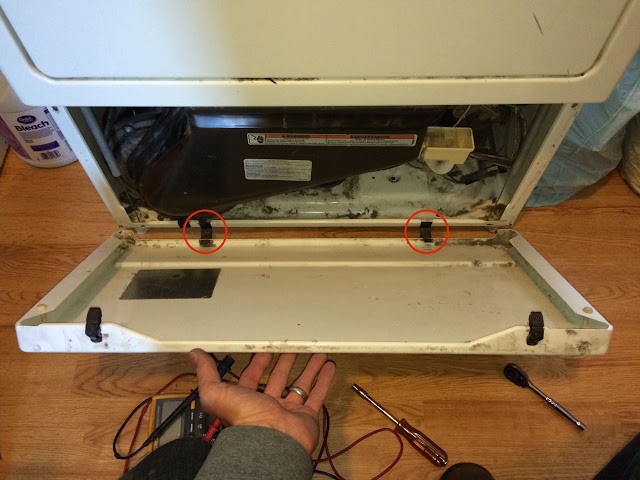 |
| Removing the lower door |
Step 4: Locate the igniter.
This was what I thought was causing the dryer to not heat. It is the part that ignites the gas. It is the same type of igniter my gas oven has on it (and I’ve replaced it twice). The igniter is on the right side, behind and slightly to the left of the gas valve, and circled in red below:
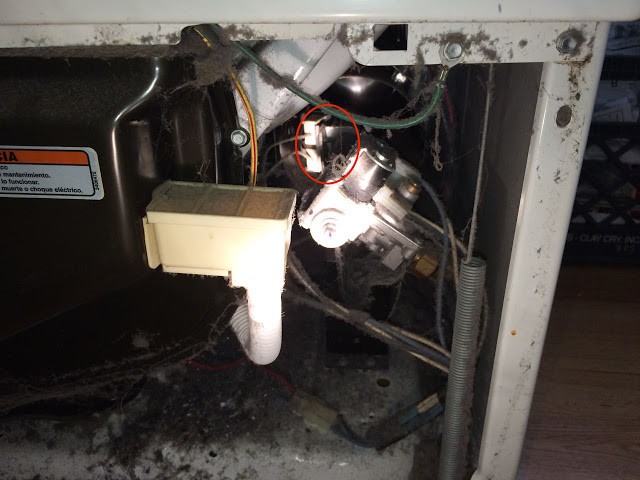 |
| Igniter Location |
Step 5: Check the resistance of the igniter.
By doing this we can determine if the igniter is bad. Disconnect the white wiring connector on the igniter and then clip your multimeter leads to each of the two wires in the connector of the igniter. I actually just took my multimeter’s alligator clips and put one side of the jaw on the outside and the other jaw on the inside and clipped them on opposing sides so they don’t short together.
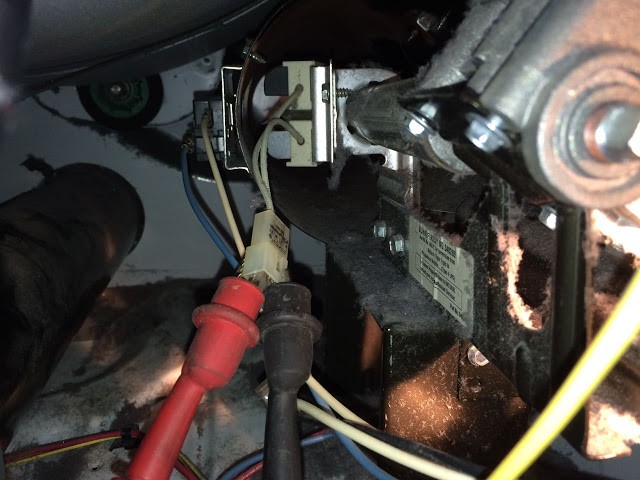 |
| My multimeter leads clipped to the two wires in the connector of the igniter |
The resistance of this igniter read 82 Ohms, which is in the range of what a good igniter would read. A bad one would most likely be an open circuit or a very high resistance like 1MegaOhm.
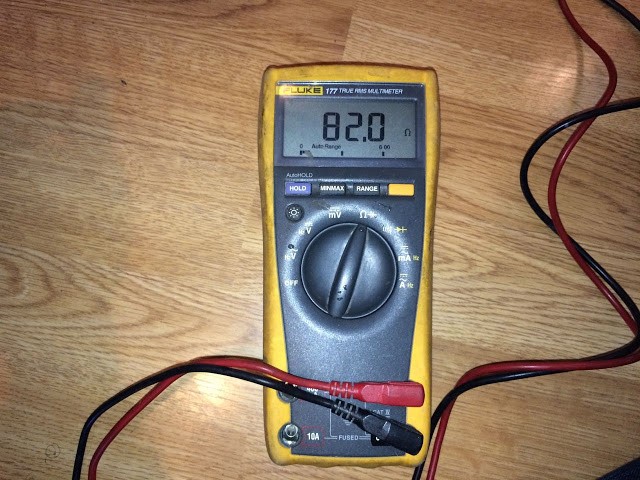 |
| Resistance reading of the dryer’s igniter — 82 Ohms |
If the igniter reads in the ~75-150 Ohm range it is good and you can plug the igniter back in. There’s only one way to connect the igniter because one side of the connector is rounded and the other side is square. If your igniter is good skip to the next step. If it’s bad then there you go, you know what you need to replace. To remove the igniter all you must do is remove one 1/4″ hex head screw as seen below:
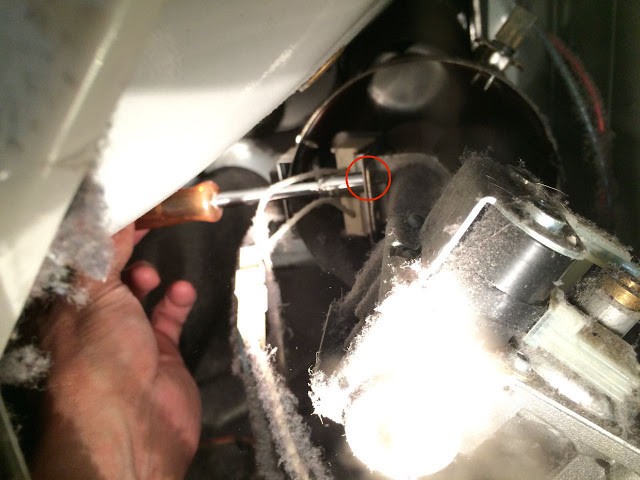 |
| Removing the single screw that holds the igniter in place |
Install your replacement igniter and the single screw and reconnect the wiring connector.
Step 6: Remove the lint screen box.
First open the door of the dryer and pull the lint screen up and out and set it aside. Then there are two screws you must remove from the black lint screen box and then it slides down and off:
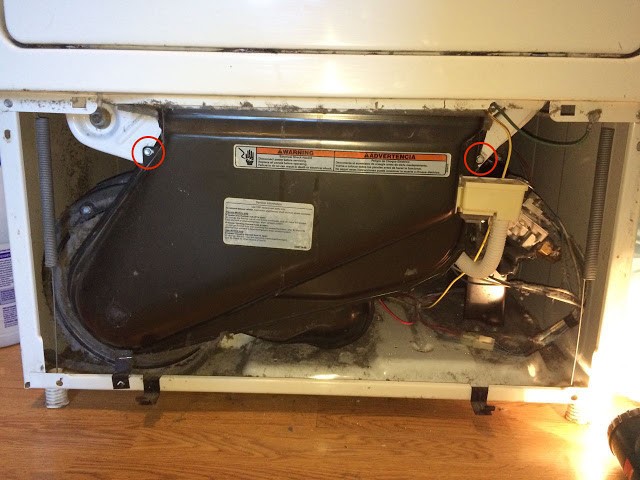 |
| Filter box screw locations |
Step 7: Locate the thermal fuse.
It can be seen here on top of the black fan box:
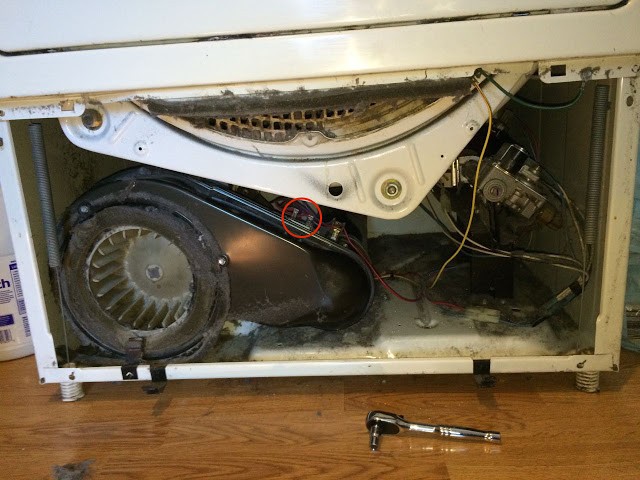 |
| Thermal fuse location on the fan box |
And closer up:
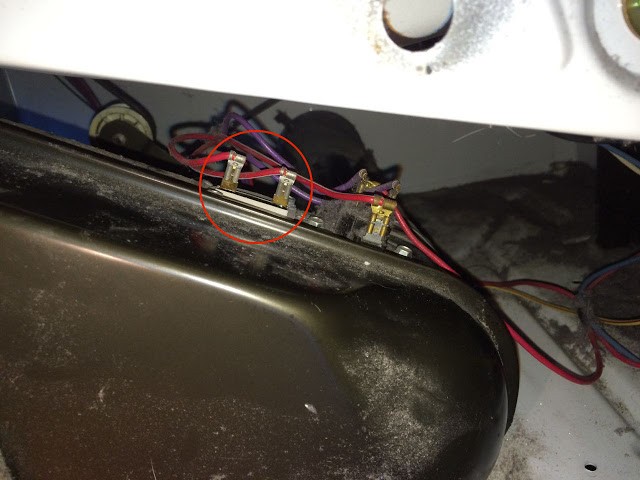 |
| Thermal Fuse Location |
On the parts explosion diagram, part number 59:
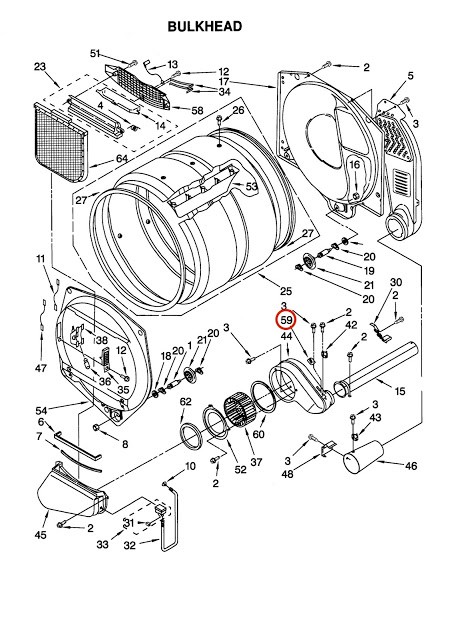 |
| Part #59 is the thermal fuse (click for a larger version) |
Step 8: Pull one of the two wiring connectors off of the thermal fuse and check the resistance between the two terminals on the fuse.
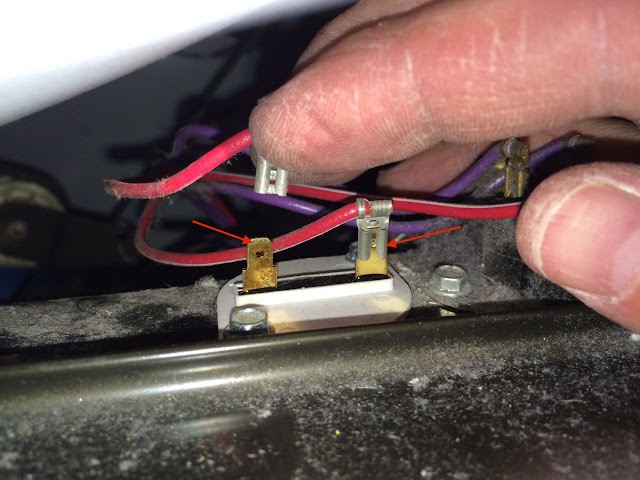 |
| Removing one of the connectors of the thermal fuse to check the fuse |
If you don’t remove one of the wires you will be measuring whatever the fuse is in parallel with so you must remove at least one (and it doesn’t matter which one you remove). This is just a fuse so it should read a short circuit, i.e. 0 ohms. I didn’t get a picture of me measuring the resistance when it was installed but here’s what you’ll see if you have a bad thermal fuse:
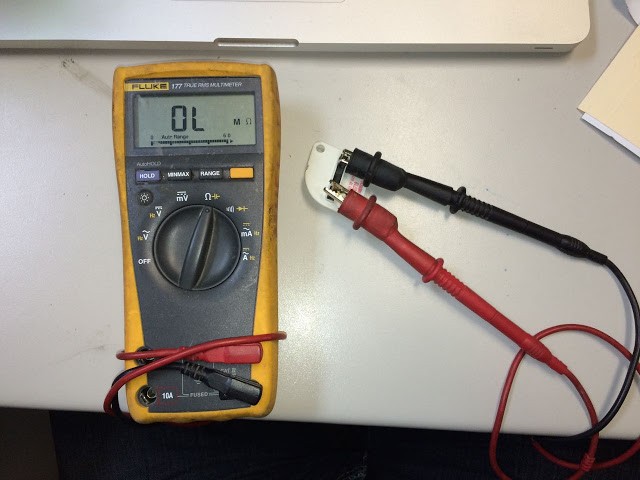 |
| A bad thermal fuse will be an open circuit (overload) |
The thermal fuse was the problem and it’s a cheap part, like $5.
Step 9: Remove the bad thermal fuse.
There are two 1/4″ hex head screws that hold it into place. I used a 1/4″ socket wrench:
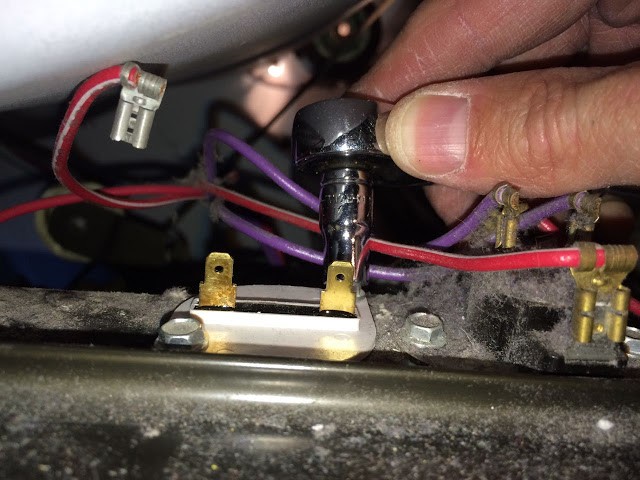 |
| Removing the two screws from the thermal fuse |
Be careful not to drop the screws into the hole that is created by removing the fuse. Here’s what it looks like removed:
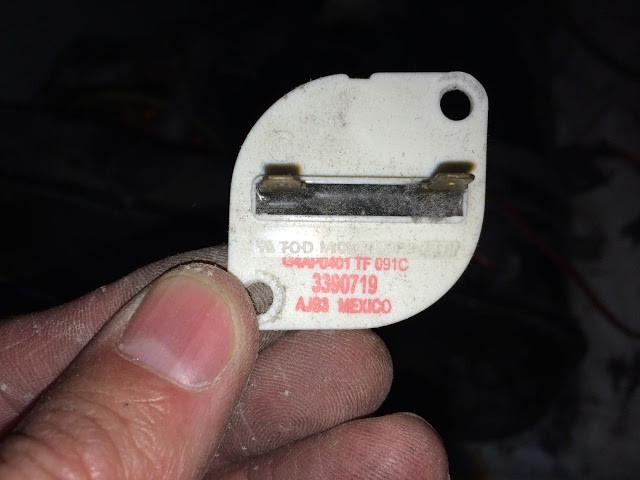 |
| Old (bad) Thermal Fuse Removed, Part Number 3390719 |
Step 10: Reinstall the new fuse.
It doesn’t matter which way it goes in and it doesn’t matter which wire connects to which terminal on the fuse either. Here’s a picture of the replacement fuse:
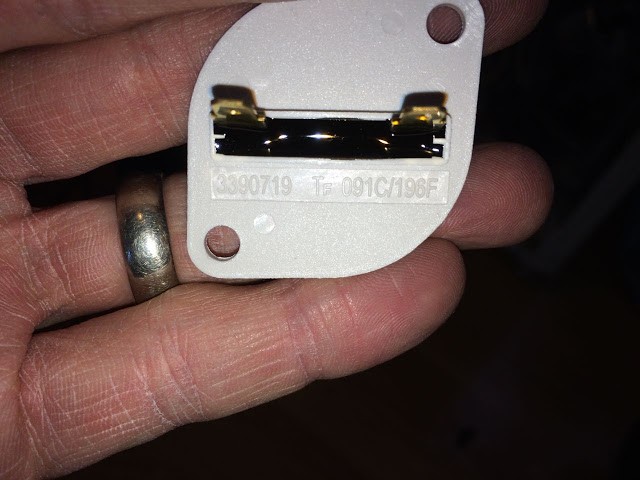 |
| Replacement Thermal Fuse Part Number 3390719 |
Again, the hex-head screws are 1/4″. Get them started by hand and then use a 1/4″ socket.
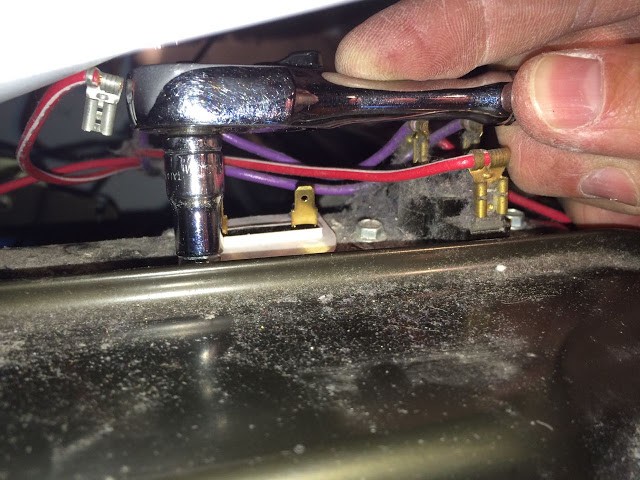 |
| Reinstalling the two 1/4″ hex-head screws on the replacement thermal fuse |
Reconnect both wires to the thermal fuse:
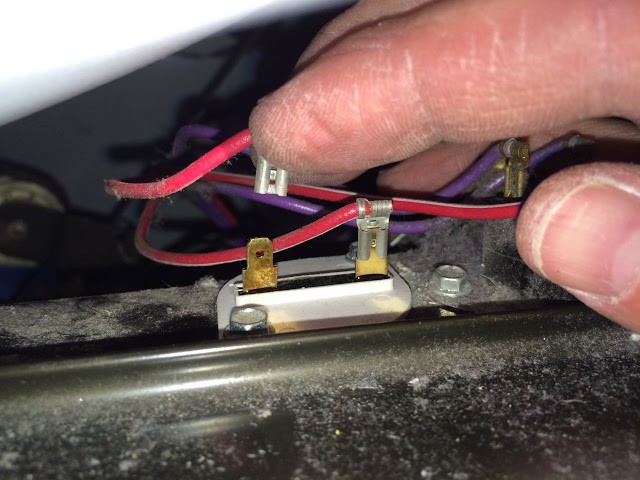 |
| Reconnecting the wires to the new thermal fuse |
Step 11: Reinstall the lint screen box.
It slips on the lint screen opening from below and then has two screws, one on each side, and there is a spring the presses it tight on the bottom left:
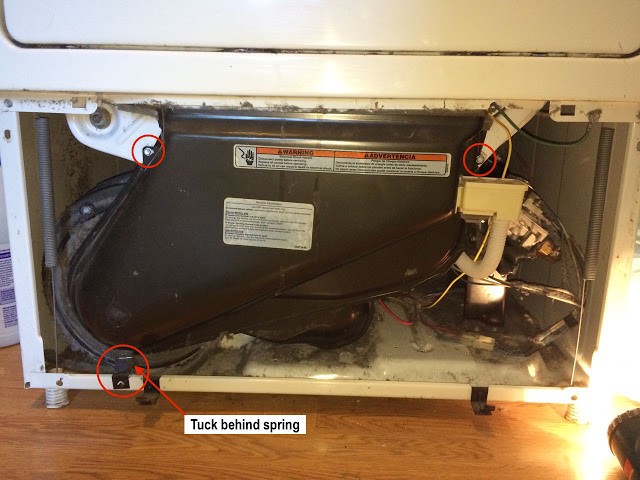 |
| The lint screen box reinstalled |
You can reinstall the lint screen too now.
Step 12: Test the dryer.
At this point you can plug it in and turn the gas back on and test it out. This is what you should see if it is working, the gas burning:
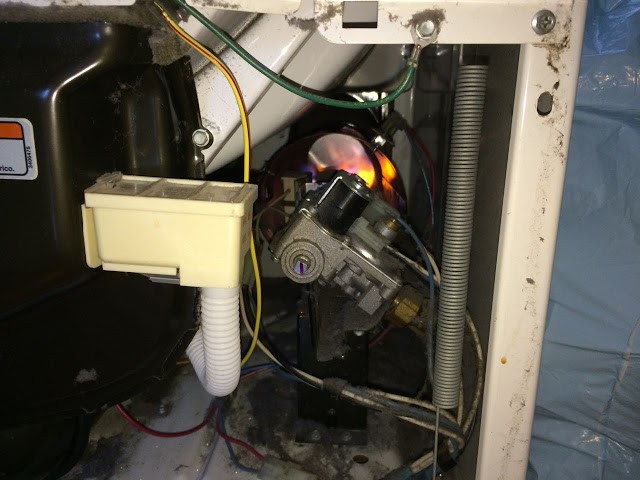 |
| As you can see, the igniter is working and the dryer lit right up once we replaced the bad thermal fuse |
Other Helpful Links
Amazon Associate Disclosure: As an Amazon Associate I earn from qualifying purchases. This means if you click on an affiliate link and purchase the item, I will receive an affiliate commission. The price of the item is the same whether it is an affiliate link or not. Regardless, I only recommend products or services I believe will add value to Share Your Repair readers. By using the affiliate links, you are helping support Share Your Repair, and I genuinely appreciate your support.

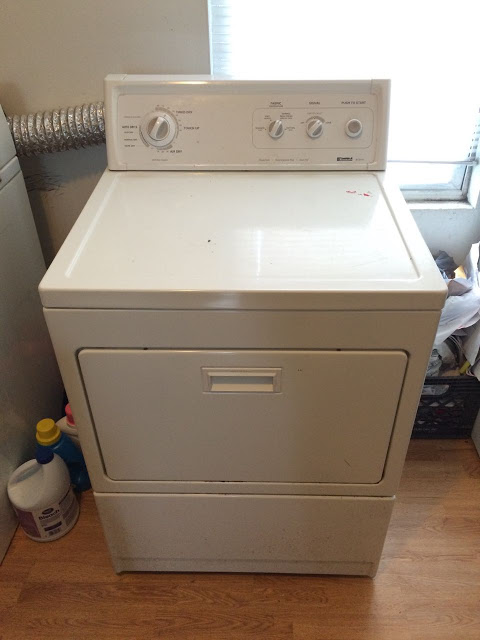

This article was just what I needed! The thermal fuse seems to be a very common issue with these dryers. Thank you so much for posting this. Great step by step instructions with pictures. Felt great to fix it myself. Good job!
Good job Bob on fixing your dryer!
Thank you for the clear repair description and pictures
hi John: my dryer is Maytag LDG309 gas, and we see the igniter light up the barrell,… on/ off every 60sec or so but the dryer does not put out enough heat, have tried on the various cycles. On top of that,..it has a horrid “moan & groan” every 90sec or so, sounds like it will quit on the very next rotation, but keeps turning. Have cleaned the ducts, it came to us 10yr ago as used, probably is 20-30yr old, knowing Maytags from that era!
Yup, that fixed it. Thanks!
Problem fixed, with mine it was the fuse. Under $7 and two screws to install. I’m thinking it was fortuitous for me and mine this fuse went when it did. It has been WAY beyond too long for me to clean the accumulated lint. I could have made a small throw pillow out of what I accumulated in my shop-vac cleaning up so I could see what I was doing. Just watch the big blue flame that fires inside the canister when the dryer is rolling and you’ll understand why I’ll be back sooner. Thank you!!
Glad you were able to repair your dryer–good job!
Oh yeah, it’s definitely the thermal fuse … it’s gone! Easy fix thanks to your tutorial.
Good to hear, thanks for checking back in and let me know if there’s anything else you can do.
So helpful! Thanks so much for sharing the knowledge…
My ignitor tested 65ohms, is this close enough to normal range or is it indicative of an ignitor on the way out?
That’s in the same ballpark of what mine read so I think you should be ok. You’ll want to check the thermal fuse because it won’t even try to light if it is blown.
John, thank you so much for your assistance and prompt response. Your article and pictures are very informative.
Hello, my 90 series model is # 11079907890, but it appears identical to the model you show. Is the repair essentially the same as the one you describe? Thanks!
Tom, as long as it is a gas dryer the troubleshooting process will be the same and the dryer should disassemble nearly identically. A thermal fuse should be a short circuit as measured with a multimeter. Let me know if you have any other questions.